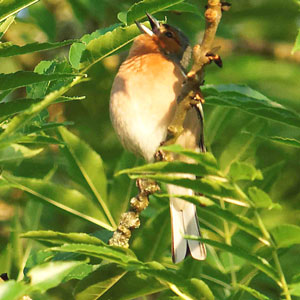Pratique | Débuter
Le sous-chant des oiseaux

Le Pinson des arbres (Fringilla coelebs) émet de préférence son sous-chant quand il est caché dans la végétation.Photographie : Jean Morillon
Introduction
Écoutez attentivement les oiseaux au printemps (mais aussi dans une moindre mesure en automne et en hiver) : on peut parfois entendre certaines espèces comme le Merle noir, le Rougegorge familier ou le Pinson des arbres chanter tranquillement, discrètement, en sourdine. On a l’impression qu’ils chantent pour eux, comme lorsque l’on fredonne doucement un air pendant que l’on fait autre chose. Cela fait aussi penser à un chanteur répétant avant de se lancer en public. Ce type de chant est appelé sous-chant (ou parfois pré-chant). Il est généralement émis depuis un buisson ou un arbre, à l’abri des regards. L’oiseau semble être ventriloque car son bec est souvent presque fermé, et il contient même parfois de la nourriture !
Le sous-chant est différent du chant typique : outre un volume sonore inférieur, il est composé de notes très variées et sa structure n’est pas nette. On ne connaît pas précisément sa fonction.
Dans cet article, nous vous présentons ce type de chant peu connu et nous abordons son rôle possible.
Abstract
In spring (and to a lesser extent in autumn and winter), listen carefully to the birds: you can sometimes hear some species such as the Blackbird, the Eurasian Robin or the Chaffinch singing quietly and discreetly. We have the feeling that they sing only for them, like when you hum softly a song while you do something else.They are like shy singers testing their talent. This type of song is called the sub-song. It is often emitted from a bush or a tree, out of sight. The bird seems to be a ventriloquist because its bill is almost closed, and it even contains food! The sub-song is different from the typical song of the species: in addition to its small volume, it is composed of very varied notes, without any particular structure. The functions of the sub-song are not really known, but there are several hypothesis.
In this article, we present you this type of song little known to the observers who do not always pay attention to it, and we list its possible functions.
Poursuivez la lecture de cet article, en vous abonnant dès maintenant !
Découvrez les Archives d’Ornithomedia.com
Pour seulement 10,00 €TTC/an (ou 6,00 € les 6 mois)
Profitez de plusieurs centaines d’articles en accès illimité et sans aucun engagement.
Compléments
À lire aussi sur Ornithomedia.com
- Pourquoi certains oiseaux chantent-ils en hiver ?
- Pourquoi certains oiseaux crient-ils et/ou chantent-ils la nuit ?
- Pour s’adapter au bruit, le rougegorge doit « prendre de la hauteur »
- Faites moins de bruit et vous verrez plus d’oiseaux en ville
- Le Ménure superbe : l’oiseau-vacarme
Dans la boutique d’Ornithomedia.com
CD « 70 chants d’oiseaux du jardin »
Produits recommandés
- La voix des oiseaux : Une nouvelle approche des cris et des chants (2 CDs audio) de Mark Constantine et The Sound Approach
- Les chants d’oiseaux d’Europe occidentale (2 CDs audio) d’André Bossus et François Charron
- Reconnaître les chants d’oiseaux (1 CD audio) de Hannu Jännes (Auteur), Owen Roberts (Auteur), Pierre Bertrand (Traduction)
- Acoustic Communication in Birds. Volume 2 : song learning and its consequences de Donald E. Kroodsma et Edward H. Miller
- Garden Bird Behaviour de Robert Burton
- Perspectives on Animal Behavior de Judith Goodenough,Betty McGuire et Elizabeth Jakob
- Bird Sounds: How and why Birds Sing, Call, Chatter, and Screech de Barry Kent MacKay
Sources
- Susan Peters et Stephen Nowicki (2017). Overproduction and attrition: the fates of songs memorized during song learning in songbirds. Animal Behaviour. Volume : 124. Pages : 255–261. www.sciencedirect.com/science/article/pii/S0003347216302342
- Denis Caron (2015). Données sur le chant des oscines. Université de Nantes. www.pedagogie.ac-nantes.fr
- Mallice (2010). L’apprentissage du chant chez les oiseaux. Axiome café. www.axiomcafe.fr/lapprentissage-du-chant-chez-les-oiseaux
- Judith Goodenough et Betty McGuire,Elizabeth Jakob (2009). Perspectives on Animal Behavior. Wiley
- Université de Lyon (2009). Latéralisation chez les animaux comme chez l’Homme. http://theses.univ-lyon2.fr
- Robert Burton (2006). Garden Bird Behaviour. New Holland Publishers
- Barry Kent MacKay (2001). Bird Sounds: How and why Birds Sing, Call, Chatter, and Screech. Stackpole Books
- Donald E. Kroodsma et Edward H. Miller (1982). Acoustic Communication in Birds. Volume 2 : song learning and its consequences. Academic Press
- W. H. Thorpe et P. M. Pilcher (1958). The nature and characteristics of sub-song. Bristh Birds. Volume : 51. Numéro : 12. Pages : 509-512. https://britishbirds.co.uk




 1 commentaire
1 commentaire
1 commentaire(s) sur ce sujet
Participer à la discussion !Erica Humbert-Droz
Pietracorbara
Posté le 30 juillet 2018
J’ai ajouté cette observation :
J’ai réalisé il y a quelques jours que les gobemouches émettaient leur cris d’alerte avec le bec fermé , pourtant rempli de la nourriture pour les oisillons, et je ne sais pas si c’est le cas pour les autres oiseaux comme les merles, les mésanges…
Source :
Erica Humbert-Droz
http://www.ornithomedia.com/observations.html
NB: dans observations, il manque le mot « fermé » (le bec fermé).